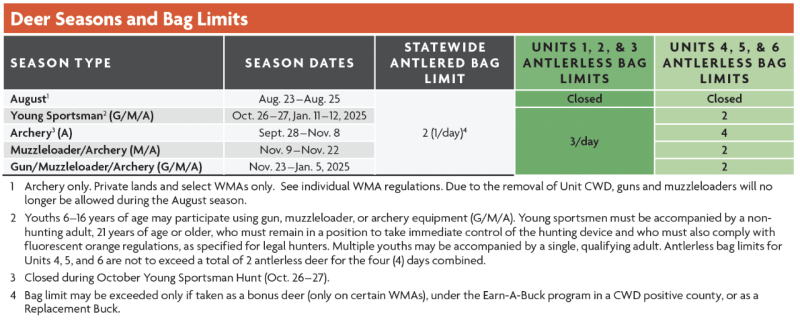
CWD Hunting Regulations
The Unit CWD designation has been removed and will no longer apply. All deer harvest regulations now coincide with the seasons and bag limits set for each of the newly designated deer management units (see below). However, the fight against CWD remains a top priority and additional harvest opportunities are still available in all CWD positive counties. Please refer to the Management & Incentive Programs webpage for more information on these opportunities. CWD positive counties include Carroll, Chester, Crockett, Dyer, Fayette, Gibson, Hardeman, Hardin, Haywood, Henderson, Henry, Lauderdale, Lewis, Madison, McNairy, Shelby, Tipton, and Weakley counties.
Carcass transportation and wildlife feeding restrictions will apply within the CWD Management Zone. If a new county becomes CWD positive (based on CWD test results) then these restrictions will immediately go into effect.
Carcass Transportation Restrictions
Deer carcass transportation and wildlife feeding restrictions apply to the CWD Management Zone. These restrictions have been put in place to reduce the spread of Chronic Wasting Disease. Carcass transport restrictions reduce the chance that an infected deer carcass becomes a source of infection in a new area. Wildlife feeding restrictions reduce deer exposure to potential infections in other deer and in the environments where deer unnaturally congregate due to supplemental feeding.
The CWD Management Zone includes Benton, Carroll, Chester, Crockett, Decatur, Dyer, Fayette, Gibson, Hardeman, Hardin, Haywood, Henderson, Henry, Madison, McNairy, Lake, Lauderdale, Lewis, Obion, Shelby, Tipton, Wayne, and Weakley Counties.
- Deer carcasses can be moved within and between counties in the CWD Management Zone.
- Once a carcass is brought into the CWD Management Zone, it cannot be moved out of the zone.
- Approved parts (listed below) are free to be transported anywhere statewide.
- Also remember, only approved parts can be transported into Tennessee from another state.
Downloadable CWD Management Zone: Carcass Transport and Feeding Restrictions Flyer for dissemination.
Approved Parts
These parts have a low risk of spreading CWD.
- Deboned meat
- Antlers, antlers attached to cleaned skull plates, cleaned skulls (where no meat or tissues are attached to the skull)
- Cleaned teeth
- Finished taxidermy and antler products
- Hides and tanned products
Examples of Unapproved Parts
These parts have a high risk of spreading CWD.
- Whole and field-dressed carcasses
- Organs
- Guts
- Uncleaned (meat and/or tissue are present) heads/skulls/skull caps
- Non-muscle tissues
Wildlife Feeding Restrictions Within CWD Management Zone
Within the CWD Management Zone the placement of grain, salt products, minerals, and other consumable natural and manufactured products is prohibited.
Feeding restrictions do not apply if the feed or minerals are:
- placed within one hundred (100) feet of any residence or occupied building; or
- placed in such a manner to reasonably exclude access by deer; or
- placed as part of a wild hog management effort authorized by the agency; or
- present from normal agricultural practices, normal forest management practices, or crop and wildlife food production practices.
Urine Lure Restriction
The use or possession of natural cervid urine while hunting is prohibited unless the product is clearly labeled bearing certification from the manufacturer that the urine was produced in a facility that:
- Complies with a federal or a federally approved chronic wasting disease herd certification program and any federal chronic wasting disease protocols and record requirements;
- Does not allow the importation of live cervids;
- Requires that all cervids exported from the facility be tested for chronic wasting disease upon death and the results are reported to the facility;
- Is inspected annually by an accredited veterinarian, including inspection of the herd and applicable records; and
- Maintains a fence at least 8 feet high around the facility and, if the facility is located within 30 miles of a confirmed positive occurrence of chronic wasting disease, is double fenced to prevent direct contact between captive and wild cervids.
- Requires an accredited veterinarian to conduct a 100% herd inspection at a minimum of every 3 years: and
- Prior to distribution, tests each lot/batch of cervid collected urine used in a scent product via the Real Time Quaking Induced Conversion (RT-QulC) assay for the presence of Chronic Wasting disease prions.
Important Safety Guidelines
Limit Your Exposure to CWD
There is no scientific evidence that CWD can be naturally transmitted to humans. However, as a general precaution, TWRA refers to the guidelines provided by the Centers for Disease Control and Prevention (CDC) which advises hunters to take the following precautions when handling and processing deer or elk in areas known to have CWD.
- Avoid sick animals. Do not shoot, handle, or consume any animal that appears sick; contact your local wildlife agency personnel.
- Have your animal processed in the area in which it was harvested so high-risk parts can be disposed of properly.
- Wear rubber/latex gloves when field-dressing carcasses.
- Minimize handling of the brain, spinal cord, eyes, spleen, tonsils, and lymph nodes of any deer or elk. Normal field dressing coupled with boning out a carcass will remove most, if not all, of these body parts. Cutting away all fatty tissue will remove the remaining lymph nodes.
- Thoroughly wash hands. Knives and other tools should be washed with warm soapy water to completely remove all visible debris and fat/grease before sanitizing. Sanitize tools by soaking them in a solution of 50 percent household bleach with 50 percent water for 20 minutes. Thoroughly rinse the bleach off. Let air dry.
- While transporting, store all portions of the animal in a container such as a cooler, bin, or bag that will not leak fluids into the environment.
- In CWD affected counties, have your animal tested and do not consume animals that test positive for CWD.
Read more about preventing exposure to CWD through the Centers for Disease Control and Prevention CWD webpage.









